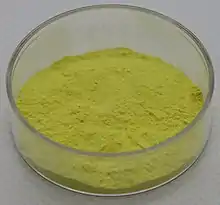Uranyl peroxide
Uranyl peroxide or uranium peroxide hydrate (UO4·nH2O) is a pale-yellow, soluble peroxide of uranium. It is found to be present at one stage of the enriched uranium fuel cycle and in yellowcake prepared via the in situ leaching and resin ion exchange system. This compound, also expressed as: UO3·(H2O2)·(H2O), is very similar to uranium trioxide hydrate UO3·nH2O. The dissolution behaviour of both compounds are very sensitive to the hydration state (n can vary between 0 and 4). One main characteristic of uranium peroxide is that it consists of small needles with an average AMAD of about 1.1 µm.
 | |
| Identifiers | |
|---|---|
| ECHA InfoCard | 100.031.671 |
| Properties | |
| UO4·nH2O | |
| Molar mass | 302.03 g/mol (as UO4) |
Except where otherwise noted, data are given for materials in their standard state (at 25 °C [77 °F], 100 kPa). | |
| Infobox references | |
The uranyl minerals studtite, UO4·4H2O, and metastudtite, UO4·2H2O, are the only minerals discovered to date found to contain peroxide. The tetrahydrate is synthesised at room temperature by reaction of uranyl nitrate hexahydrate and hydrogen peroxide.[1] The product is a light yellow powder.
References
- Schwerdt, Ian J.; Brenkmann, Alexandria; Martinson, Sean; Albrecht, Brent D.; Heffernan, Sean; Klosterman, Michael R.; Kirkham, Trenton; Tasdizen, Tolga; McDonald IV, Luther W. (2018-08-15). "Nuclear proliferomics: A new field of study to identify signatures of nuclear materials as demonstrated on alpha-UO3". Talanta. 186: 433–444. doi:10.1016/j.talanta.2018.04.092. ISSN 0039-9140.
- Some Chemistry of Uranium
- Freeman, Marvin D.; Stover, Dennis E. (1999). "The Smith Ranch Project: a 1990s In-situ Uranium Mine". The Uranium Institute Twenty Fourth Annual International Symposium. The Uranium Institute. Retrieved 22 November 2011.
- Kubatko, K. -A. H.; Helean, K. B.; Navrotsky, A.; Burns, P. C. (2003). "Stability of Peroxide-Containing Uranyl Minerals". Science. 302 (5648): 1191–1193. doi:10.1126/science.1090259. PMID 14615533. S2CID 44415700.